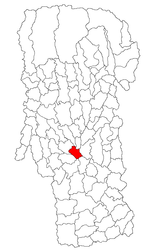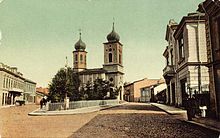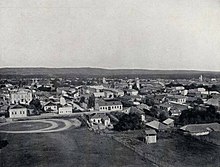Pitești
Pitești | |
|---|---|
    | |
|
Coat of arms | |
 Location in Argeș County | |
| Coordinates: 44°51′38″N 24°52′4″E / 44.86056°N 24.86778°E | |
| Country | Romania |
| County | Argeș |
| Government | |
| • Mayor (2020–2024) | Cristian Gentea[1] (PSD) |
| Area | 40.7 km2 (15.7 sq mi) |
| Population (2021-12-01)[2] | 141,275 |
| • Density | 3,500/km2 (9,000/sq mi) |
| Time zone | EET/EEST (UTC+2/+3) |
| Vehicle reg. | AG |
| Website | primariapitesti |
Pitești (Romanian pronunciation:
Inhabited since
History
Early history
The earliest traces of human settlements in this area relate to the
The first recorded mention of Pitești itself was on May 20, 1386, when
At the time, the locality was only extending on the left bank of the Argeș, and gradually expanded over the river, reaching the hill slopes to the west[3] (in the 19th century, it completely absorbed Târgul din Deal).[6] While Pitești was commonly designated as a high-ranking town, a village of Pitești was still mentioned as late as 1528, which led some historians to conclude that the village and urban area coexisted within the same boundaries.[7]
Early Modern period

Although princely quarters have not been uncovered, among the rulers to issue documents from Pitești were
Under Vlad Vintilă, who allied himself with the
Constantin Șerban financed the building of the
18th and early 19th centuries

In November 1714, as a direct result of Swedish defeats in the
In 1780, Tuscan numismatist Domenico Sestini passed through the Argeș region, and described the town as having 250 houses and 7 churches.[10] In 1804, the citizens requested to have an upper school opened (to offer lectures in Greek, the educational language of the time); their request was denied by Prince Constantine Ypsilantis.[11] During the 1790s, Pitești was visited by Luigi Mayer, a German pupil of Giovanni Battista Piranesi, who left etchings of the region (including the very first one of Pitești);[10] they were published in London in 1810, with text by a T. Bowyer, whose caption for Pitești read "nothing more wild or romantic can be conceived".[12]
The town was an important location for events relating to the last stage of the
Late 19th and early 20th century


The city was developed further after the
By 1872, a national railway connection with the capital Bucharest and Târgoviște was built, at the same time as one linking Bucharest with Ploiești through Chitila.[16] Overseen by the German financier Bethel Henry Strousberg, this was the second project of its kind in Romania (after the Bucharest-Giurgiu rail link of 1869).[16] The Pitești Town Hall was completed in 1886, and currently houses an art gallery.[3] The Argeș County Prefecture, designed by Dimitrie Maimarolu, was erected in 1898–1899 on the site previously occupied by an Orthodox hermitage; it is the present-day site of the County Museum of History and Natural Sciences.[3] Both buildings are eclectic in style, and feature frescoes painted by Iosif Materna.[3]

Pitești experienced urbanization and economic development with several changes in landscape and a number of regional firsts. In 1868–1869, Pitești was the first city in Romania to have a recorded
From late autumn 1916 to 1918, during the
World War II and communism

Pitești was affected in various ways by World War II and its
In the 1950s, while serving as capital of
In parallel, Pitești underwent numerous changes in landscape, including the completion of the
Geography
The city is part of the historical region of Wallachia, situated in its north and in the westernmost part of its Muntenian subregion. It lies on the right bank of the Argeș, where the river meets its tributary, Râul Doamnei.
Pitești is situated 280 metres (918.64
Pitești is adjacent to two reservoirs on the Argeș, in its Prundu area and in nearby Bascov (the Budeasa Dam).[31] It is situated downstream from Lake Vidraru and upstream from the reservoir in Bălilești.[31]
Climate
According to the Köppen climate classification, the city lies within the humid continental climate (Dfb) category. Average annual temperatures range between 9 °C and 10 °C. The average January temperature is -2.4 °C, while the average July temperature is 20.8 °C.[32]
| Climate data for Pitești | |||||||||||||
|---|---|---|---|---|---|---|---|---|---|---|---|---|---|
| Month | Jan | Feb | Mar | Apr | May | Jun | Jul | Aug | Sep | Oct | Nov | Dec | Year |
| Mean daily maximum °C (°F) | 4 (39) |
7 (45) |
12 (54) |
17 (63) |
23 (73) |
26 (79) |
29 (84) |
28 (82) |
23 (73) |
18 (64) |
10 (50) |
5 (41) |
17 (62) |
| Mean daily minimum °C (°F) | −4 (25) |
−3 (27) |
1 (34) |
6 (43) |
11 (52) |
14 (57) |
16 (61) |
16 (61) |
11 (52) |
7 (45) |
1 (34) |
−3 (27) |
6 (43) |
| Average precipitation mm (inches) | 26.5 (1.04) |
13.3 (0.52) |
30.9 (1.22) |
40.1 (1.58) |
67.6 (2.66) |
65.1 (2.56) |
60.0 (2.36) |
66.0 (2.60) |
46.9 (1.85) |
38.8 (1.53) |
29.8 (1.17) |
29.3 (1.15) |
514.3 (20.24) |
| Source: [33] | |||||||||||||
Demographics
| Year | Pop. | ±% |
|---|---|---|
| 1835 | 2,755 | — |
| 1859 | 7,229 | +162.4% |
| 1899 | 15,669 | +116.8% |
| 1930 | 19,532 | +24.7% |
| 1941 | 26,551 | +35.9% |
| 1948 | 29,007 | +9.3% |
| 1956 | 38,330 | +32.1% |
| 1966 | 60,113 | +56.8% |
| 1977 | 123,735 | +105.8% |
| 1992 | 179,337 | +44.9% |
| 2002 | 168,458 | −6.1% |
| 2011 | 155,383 | −7.8% |
| 2021 | 141,275 | −9.1% |
| Source: [34][35][36] | ||
As of 2021 census data, 141,275 inhabitants live within the city limits,[37] a decrease from the figure recorded at the 2011 census.
Romania's
The population of Pitești grew between the 1830s and the 1990s, with the most sustained period of growth occurring after the 1950s, when industrial development created jobs and attracted residents from nearby settlements. The population peaked at an estimated 187,000 in 1997, then stagnated until 2001, and has gradually decreased since that time. The drop is particularly noticeable among the male population: this segment not only has a higher mortality and lower life expectancy, but also, due to de-industrialization, emigrated in search of work in significant numbers.[42]
Economy
Pitești is one of the most industrialized cities in Romania. It is the center of the automotive industry in the country: the
The city is surrounded by hills rich in wineries and plum orchards. The latter give one of the finest Romanian țuicas: țuica de Pitești. The Ștefănești winery, situated on the opposite bank of the Argeș River, is one of the best known in Romania.
Culture

Theatre
Pitești is home to a County Theater; established in 1948, it was named in honor of playwright
The first written record of a theatrical performance in the city dates to 1848, when Constantin Halepliu set up a troupe. Following that year's revolution, several actors, Halepliu included, were arrested, and the theatre closed until 1856. A Communal Theatre was built in 1914–1916. Since 1948, the local acting ensemble has performed both in other Romanian cities and abroad, including in Poland, Serbia, Bulgaria, Italy and Spain.[44]
Education

The city houses two universities: the state-run University of Pitești and the private Constantin Brâncoveanu University (founded 1991, with branches in Brăila and Râmnicu Vâlcea). There are 17 secondary education institutions, including two main high schools—the Ion Brătianu National College (founded 1866) and the Zinca Golescu National College. There are also 20 primary schools, 23 kindergartens and 10 nursery schools.[45]
A public library, named after intellectual figure Dinicu Golescu, was planned in 1869 by Paraschiva Stephu, a female member of the upper class, who drew up a will leaving 200 Austrian ducats for the purpose of creating a library. The institution became operational in 1880, and a large part of the volumes were bequeathed by historian George Ionescu-Gion immediately following his death in 1904. His donation included over a thousand books in Romanian, French and Italian.[46][47] The library moved into its current headquarters in the city center in 2003.[47]
Festivals
Each year during springtime, Pitești is host to a festival and fair known as Simfonia lalelelor (the "Tulip Symphony"). Tulips were introduced locally in 1972–1973, when around 3,000 bulbs brought from Arad and Oradea were planted in its central area, along with other flowers.[48] Pitești consequently acquired a reputation as a tulip-growing area, and the flower-themed festival was first organized by the local authorities in 1978.[48] Typically held in the cultural centre building (Casa Cărții), the festival also includes folk music performances, international scientific conferences, an art exhibit and youth sport competitions.[49]
Sport
The major
Pitești is home to an
Gallery
-
Pitești Art Museum
-
Cinema Modern in central Pitești
-
Old building on Victoriei Street
-
Old buildings on Victoriei Street
-
The Dinu Lipatti Art High School
-
The Pitești Synagogue
-
City Museum
-
View of Sfânta Vineri Street
-
1907 Park
-
Protected tree on Egalității Street
-
Memorial to soldiers fallen in the Russo-Turkish War (1877–1878)
-
Townhouse (Gabroveni Inn) on Sfânta Vineri Street
-
Historical building and Social Democratic Party headquarters
Notable people
- Ion Antonescu
- Ilie Bărbulescu
- Mauriciu Blank
- Alexandru Bogdan-Pitești
- Dimitrie Brătianu
- Ion Brătianu
- Armand Călinescu
- Corneliu Calotescu
- Nicolae Comănescu
- Nicolae Dică
- Nicolae Dobrin
- Ruxandra Dragomir
- Haralamb H. Georgescu
- Al. Gherghel
- Gheorghe Ionescu-Gion
- Alexandru Kirițescu
- Cristian Minculescu
- Adrian Neaga
- Marian Oprea
- Constance Pascal
- Sebastian Papaiani
- Mircea Pârligras
- Nicolae Penescu
- Costin Petrescu
- Rudolf Schweitzer-Cumpăna
- Ioan Sion
- Smiley
- Lavinia Stan
- Bogdan Stancu
- Cristian Tănase
- Tudor Teodorescu-Braniște
- Teo Trandafir
- Ion Trivale
- Lucian Turcescu
- Robert Turcescu
- Adrian Ungur
- Zavaidoc
Twin towns – sister cities
 Beit Jala, Palestine
Beit Jala, Palestine Borlänge, Sweden
Borlänge, Sweden Bydgoszcz, Poland
Bydgoszcz, Poland Caserta, Italy
Caserta, Italy Chongqing, China
Chongqing, China Gyumri, Armenia
Gyumri, Armenia Kragujevac, Serbia
Kragujevac, Serbia Muntinlupa, Philippines
Muntinlupa, Philippines Nafplio, Greece
Nafplio, Greece Ourém, Portugal
Ourém, Portugal Springfield, Ohio, United States
Springfield, Ohio, United States Tynaarlo, Netherlands
Tynaarlo, Netherlands
Notes
- ^ "Results of the 2020 local elections". Central Electoral Bureau. Retrieved 8 June 2021.
- ^ "Populaţia rezidentă după grupa de vârstă, pe județe și municipii, orașe, comune, la 1 decembrie 2021" (XLS). National Institute of Statistics.
- ^ a b c d e f g h (in Romanian) "Istoria Orașului" Archived 2013-01-13 at archive.today, at Muzee din regiunile României Archived October 19, 2008, at the Wayback Machine; retrieved July 17, 2007
- ^ Giurescu, p.33
- ^ (in Romanian) Dragoș Măndescu, Castrul roman de la Albota - un monument ignorat la marginea Piteștilor, at the Pitești Cultural Center; retrieved July 17, 2007
- ^ a b Giurescu, p.47
- ^ a b c d e f g h i j (in Romanian) Gerard Călin, Reședința domnească temporară de la Pitești, at the Pitești Cultural Center; retrieved July 17, 2007
- ^ Andrei Oțetea, The History of the Romanian People, Editura Științifică, Bucharest, 1970, p.446
- ^ (in Romanian) "Armeni - Scurt istoric", at Divers Archived 2018-04-21 at the Wayback Machine; retrieved July 17, 2007
- ^ a b c d e f g h (in Romanian) Mariu Păduraru, Orașul Pitești văzut de călători străini, at the Pitești Cultural Center; retrieved July 17, 2007
- ISBN 1-84511-066-8
- ISBN 0-7190-6639-5
- The New Monthly Magazine and Humorist, Vol. 91, 1851, p.33 D2
- ^ a b c d e (in Romanian) Mircea Crăciun, Relicve din perioada dictaturii comuniste în județul Argeș, at the Memoria Digital Library; retrieved July 17, 2007
- OCLC 6890267
- ^ a b Giurescu, p.155
- ISBN 0-8223-1241-7
- ISBN 978-973-8369-21-4
- ^ Tudor Ciumara, "Contributions to the History of Management Consulting in Communist Romania", in Procedia Economics and Finance, 8/2014, p.176
- ^ Pamfil Șeicaru, La Roumanie dans la Grande guerre, Éditions Minard, Paris, 1968, p.332-334
- ^ (in Romanian) Al. Săndulescu, "Mâncătorul de cărți" Archived 2012-02-26 at the Wayback Machine, in România Literară, Nr. 11/2008
- ^ Nicolae Ciobanu, "Armand Călinescu: Jertfă pentru liniștea și independența țării. «Omul de oțel» împotriva Gărzii de Fier", in Dosarele Istoriei, 6/IV (1999), p.60
- ISBN 1-4039-9341-6
- ISBN 0-8283-2029-2
- ^ Cioroianu, p.317
- ^ Cioroianu, p.318
- ^ (in Romanian) Teodor Wexler, "Procesul sioniștilor", in Memoria; retrieved July 17, 2007
- ^ Monografia geografică, p.100, 191, 238, 239-241
- ^ Monografia geografică, p.239-240
- ^ Monografia geografică, p.191
- ^ Ministry of the Environment and Sustainable Development, p.64/105-65/105; retrieved July 19, 2007
- ^ a b Geographic location Archived 2015-06-27 at the Wayback Machine at Pitești City Hall; retrieved July 21, 2015
- ^ Pitești Monthly Climate Average (2000-2012) at World Weather Online; retrieved July 21, 2015
- ^ (in Romanian) Population as of 20 October 2011[permanent dead link], INSSE; retrieved July 5, 2013
- ^ Ilie Bădălan, "Municipiul Pitești — centru industrial în plină dezvoltare", in Revista de statistică, vol. 22/1973, p.53 (data for 1835–1941)
- ^ (in Romanian) "Population at the 1948, 1956, 1966, 1977, 1992 and 2002 Censuses by Municipalities and Towns", INSSE; retrieved August 7, 2015 (data for 1948–2002)
- ^ "Populaţia rezidentă după grupa de vârstă, pe județe și municipii, orașe, comune, la 1 decembrie 2021" (in Romanian). INSSE. 31 May 2023.
- ^ (in Romanian) Populația stabilă după etnie - județe, municipii, orașe, comune Archived 2016-01-18 at the Wayback Machine, INSSE; retrieved August 15, 2015
- ^ (in Romanian) Populația stabilă după religie - județe, municipii, orașe, comune Archived 2013-09-21 at the Wayback Machine, INSSE; retrieved August 15, 2015
- ^ (in Romanian) Populația statornică în 1930, p. 16, Institutul Central de Statistică; retrieved August 15, 2015
- ^ (in Romanian) Populația statornică în 1930, p. 17, Institutul Central de Statistică; retrieved August 15, 2015
- ^ "Growth Trends of the Demographic Structures in the City of Pitești" (PDF). Romanian Review of Regional Studies. VII: 91–98. 2011. Archived from the original (PDF) on 2016-03-04. Retrieved 2015-06-26.
- ^ România Liberă, June 13, 2007
- ^ a b c (in Romanian) Teatrul Alexandru Davila at the Argeș County Council Archived 2008-02-06 at the Wayback Machine; retrieved July 17, 2007
- ^ General Schools, High Schools, Universities at Pitești City Hall; retrieved November 21, 2008
- ^ (in Romanian) Biblioteca Județeană Archived 2007-10-11 at the Wayback Machine at the Argeș County Council Archived 2008-02-06 at the Wayback Machine; retrieved July 17, 2007
- ^ a b (in Romanian) Biblioteca Județeană Argeș "Dinicu Golescu” at the National Library of Romania; retrieved July 21, 2015
- ^ a b (in Romanian) "Istoria lalelelor", at the Simfonia lalelelor official site; retrieved March 8, 2008
- ^ Tulip Symphony at Pitești City Hall; retrieved July 21, 2015
- ^ (in Romanian) Amir Kiarash, "FC Argeș, clubul care i-a lansat pe Dobrin, Mutu și Dică, a intrat în insolvență. Povestea tristă a decăderii", in Adevărul, June 14, 2013; retrieved November 21, 2013
- ^ (in Romanian) Cristina Stancu, "FC Argeş revine Municipiului Piteşti", in Adevărul, June 17, 2017; retrieved June 25, 2017
- ^ (in Romanian) Sporting Pitești (official site)
- ^ "Orașe înfrățite" (in Romanian). Pitești. Archived from the original on 2020-07-09. Retrieved 2021-10-01.
References
- Monografia geografică a Republicii Populare Romîne, Vol. I: "Geografia fizică", Editura Academiei RPR, Bucharest, 1960
- ISBN 973-669-175-6
- OCLC 1279610
External links
- "University of Pitești".
- "Muzeul Sighet: Sala 50 – Fenomenul Pitești" (in Romanian). Memorial of the Victims of Communism and of the Resistance. 29 May 2009.
















